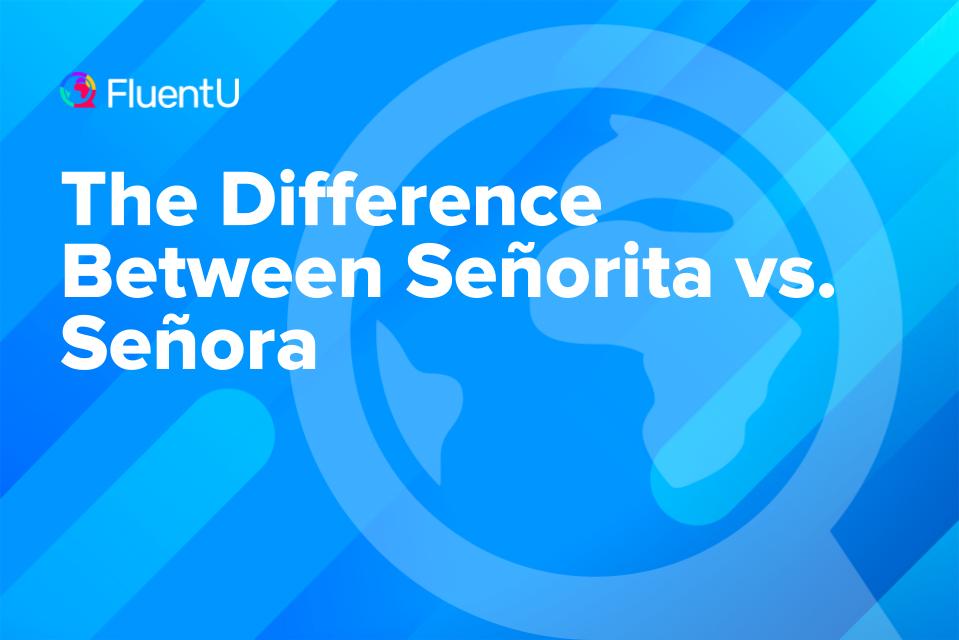The Difference Between Señorita vs. Señora

If you think that señora and señorita are interchangeable, you’re in for a surprise. They’re different titles with separate applications—in general, señora is used to refer to older women or married women, and señorita is used to refer to younger women.
But if you want to know more about the differences between the two terms and what situations they can be used in, check out the rest of this guide.
Download: This blog post is available as a convenient and portable PDF that you can take anywhere. Click here to get a copy. (Download)
Understanding the Difference between Señorita and Señora
English titles for females include Miss, Ma’am, Mrs. and sometimes Ms.
It’s good to note that Spanish doesn’t have anything quite like the Ms. title. Courtesy titles for women in Spanish are señorita and señora.
Let’s see just what makes these two similar words different—and when to use them.
Señorita
Señorita is the courtesy title commonly used for younger women. Most would agree that it’s similar to the English “Miss” or even “Ms.”
It’s used to address unmarried women. So, if you know the new neighbor or your coworker is single, using señorita when you speak with her is completely on point!
Señora
Señora is the courtesy title that references and addresses older women, married women and unmarried older women.
It’s impolite to address these categories of women by their first names unless you’re given permission to do so.
Señora is often used during employment interviews. However, señora also has a more unique social implication. Sometimes it’s used to ask whether or not a woman is a virgin, regardless of her age or marital standing.
Bonus Term: Doña (Ma’am)
While we’re discussing señora, it’s a good time to mention one more female courtesy title: doña.
Doña isn’t used as frequently as señora, but there’s a good chance you’ll hear it if you’re traveling in a Spanish-speaking country. This honorific title is comparable to ma’am and is another form of showing respect. It’s even a step beyond señora.
Doña is followed by a woman’s first name, rather than her surname. Close friends called my grandmother Doña María and she was always pleased to hear them do so.
Choosing Between Señorita and Señora
It might seem as if it’s just a case where young, unmarried women get one title and older, married women hear the other. Hey, that’s what the Real Academia Española says.
However, there’s a gray area where this topic is concerned.
Some Spanish-speaking people consider it polite to call every woman señorita. Regardless of age or marital status, some apply this title to every female they meet.
This practice has the potential to either flatter or offend women who might be accustomed to hearing señora rather than señorita when they’re referenced or addressed.
Others feel exactly the opposite, using señora as a form of respect regardless of the age or marital status of the woman they’re speaking with. The difference comes down to the different cultures around the Spanish-speaking world, as well as individual preferences.
The best way to navigate this issue is to take cues from others if you’re unsure. Here are a few tips to help you out:
- It’s often easiest to gauge the correct usage by the introduction cues you receive when meeting someone. If the person conducting the introduction chooses one title over the other, follow that lead! And if everyone is using the formal usted form to address each other, stay consistent and use the formal señora.
- Also, remember that regional and cultural differences can influence which title you use. If you’re in a country, region or social group where everyone’s pretty casual, don’t overthink the issue too much.
- As a last resort, pay attention to how the woman reacts to the title you use. If you use the wrong one, you’ll probably know pretty quickly! Don’t worry if you don’t get it right every time.
You can also prepare by seeing how these two titles are used in different contexts. If there isn’t a Spanish person around to show you, you can still learn from Spanish media, particularly video or audio content that features realistic speech.
Examples include Spanish podcasts, radio and certain TV shows. You could also use the immersive Spanish videos available on the language learning program FluentU.
FluentU takes authentic videos—like music videos, movie trailers, news and inspiring talks—and turns them into personalized language learning lessons.
You can try FluentU for free for 2 weeks. Check out the website or download the iOS app or Android app.
P.S. Click here to take advantage of our current sale! (Expires at the end of this month)

How to Use Spanish Courtesy Titles
Courtesy titles are part of every language. They serve to identify the person being addressed. Also, they’re terms of politeness that make social interactions pleasant and refined.
There are a few things to note about señora vs. señorita:
- In Spanish, just like in English, female courtesy titles are placed directly before the woman’s name.
- Sometimes when they’re written, they’re spelled out completely and appear as señorita and señora. When used in a sentence, they aren’t capitalized.
- There are instances when the titles will be abbreviated. If they’re not spelled out, señorita becomes Srta. and señora is shortened to Sra. When they’re used as abbreviations, both words are capitalized.
- If the señorita or señora who’s the object of the discussion isn’t being addressed directly, Spanish grammar rules direct us to use the definite article la (the) before both señorita and señora.
Directly addressing a woman using a courtesy title looks like this:
Sra. Brown, ¿está comprando víveres para la fiesta? (Mrs. Brown, are you buying groceries for the party?)
Señorita López, ese vestido es muy bonito. (Miss Lopez, that dress is very pretty.)
Sra. Cook, ¡es un placer verla en el parque! (Mrs. Cook, it is nice to see you at the park!)
Indirectly referencing a woman using a courtesy title takes on the la (the) and looks like this:
La Sra. Brown está comprando víveres para la fiesta. (Mrs. Brown is buying groceries for the party.)
El vestido de la señorita López es muy bonito. (Miss Lopez’s dress is very pretty.)
Es agradable ver a la señora Cook en el parque. (It is nice to see Mrs. Cook at the park.)
Notice that when you either address or reference a woman, it’s acceptable to either abbreviate or write out the appropriate courtesy title.
So, which one is the best to use—señora vs. señorita? The rules are pretty fluid, as we’ve seen.
The best way to ensure your social interactions will be successful is to smile when you speak. Friendliness counts—as much as politeness—so smile and have fun!
Download: This blog post is available as a convenient and portable PDF that you can take anywhere. Click here to get a copy. (Download)
And One More Thing…
If you've made it this far that means you probably enjoy learning Spanish with engaging material and will then love FluentU.
Other sites use scripted content. FluentU uses a natural approach that helps you ease into the Spanish language and culture over time. You’ll learn Spanish as it’s actually spoken by real people.
FluentU has a wide variety of videos, as you can see here:

FluentU brings native videos within reach with interactive transcripts. You can tap on any word to look it up instantly. Every definition has examples that have been written to help you understand how the word is used. If you see an interesting word you don’t know, you can add it to a vocab list.

Review a complete interactive transcript under the Dialogue tab, and find words and phrases listed under Vocab.

Learn all the vocabulary in any video with FluentU’s robust learning engine. Swipe left or right to see more examples of the word you’re on.

The best part is that FluentU keeps track of the vocabulary that you’re learning, and gives you extra practice with difficult words. It'll even remind you when it’s time to review what you’ve learned. Every learner has a truly personalized experience, even if they’re learning with the same video.
Start using the FluentU website on your computer or tablet or, better yet, download the FluentU app from the iTunes or Google Play store. Click here to take advantage of our current sale! (Expires at the end of this month.)







